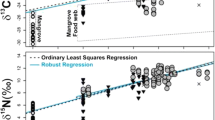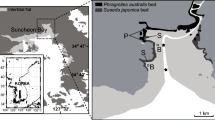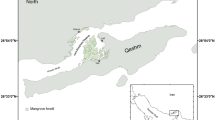Abstract
Stable isotope techniques are widely applied in aquatic food web research to infer trophic position or to estimate the relative contributions of different dietary resources. The accurate consideration of carbon (C) and nitrogen (N) discrimination in organisms is a critical prerequisite for such studies. Isotopic discrimination of invertebrates may differ systematically between temperate and tropical freshwater environments, but there are little data available on discrimination factors of tropical invertebrates. Here, we analyzed the C (Δ13C) and N discrimination (Δ15N) of eight taxa of benthic freshwater invertebrates from a Southeastern Brazilian tropical catchment, six predator and two shredder species. Predators showed a high variability in Δ13C (−1.5 to 1.3; min–max), but shredders exhibited a lower variability and had negative Δ13C values (−2.1 to −1.8). Values of Δ15N were also highly variable among both predators and shredders, but shredders had negative and lower values (−0.9 to −0.1) than predators (0.0 to 9.1). Tissue turnover rates were equal to or higher than 0.02 d−1 for all invertebrates, suggesting that experiment durations of 50 days may be sufficient for future isotopic discrimination experiments with tropical freshwater invertebrates. Our results suggest that Δ13C enrichment, and to a minor degree also Δ15N enrichment, may not always occur in tropical freshwater invertebrates.

Similar content being viewed by others
References
Adams TS, Sterner RW (2000) The effect of dietary nitrogen content on trophic level 15N enrichment. Limnol Oceanogr 45:601–607
Anderson C, Cabana G (2005) δ15N in riverine food webs: effects of N inputs from agricultural watersheds. Can J Fish Aquat Sci 62:333–340
APHA (American Public Health Association) (1998) Standard Methods for the Examination of Water and Wastewater, 20th edn. American Public Health Association American Water Works Association, Water environment federation, Washington, DC
Armitage PD (1995) Chironomidae as food. In: Armitage PD, Cranston PS, Pinder LCV (eds) The chironomidae: biology and ecology of non-biting midges. Chapman & Hall, London, pp 423–425
Banas D, Vollaire Y, Danger M, Thomas M, Oliveira-Ribeiro CA, Roche H, Ledore Y (2009) Can we use stable isotopes for ecotoxicological studies? Effect of DDT on isotopic fractionation in Perca fluviatilis. Chemosphere 76:734–739
Barnes C, Sweeting CJ, Jennings S, Barry JT, Polunin NVC (2007) Effect of temperature and ration size on carbon and nitrogen stable isotope trophic fractionation. Funct Ecol 21:356–362
Boulton AJ, Boyero A, Covich AP, Dobson M, Lake S, Pearson R (2008) Are tropical streams ecologically different from temperate streams? In: Dudgeon D (ed) Tropical stream ecology. Academic Press, London, pp 257–284
Brauns M, Gücker B, Wagner C, Garcia XF, Walz N, Pusch MT (2011) Human lakeshore development alters the structure and trophic basis of littoral food webs. J Appl Ecol 48:916–925
Brito EF, Moulton TP, Souza ML, Bunn SE (2006) Stable isotope analysis indicates microalgae as the predominant food source of fauna in a coastal forest stream, south-east Brazil. Austral Ecol 31:623–633
Burress ED, Gangloff MM, Siefferman L (2013) Trophic analysis of two subtropical South American freshwater crabs using stable isotope ratios. Hydrobiologia 702:5–13
Caut S, Angulo E, Courchamp F (2009) Variation in discrimination factors (Δ15N and Δ13C): the effect of diet isotopic values and applications for diet reconstruction. J Appl Ecol 46:443–453
Chikaraishi Y, Ogawa NO, Kashiyama Y, Takano Y, Suga H, Tomitani A, Miyashita H, Kitazato H, Ohkouchi N (2009) Determination of aquatic food-web structure based on compound-specific nitrogen isotopic composition of amino acids. Limnol Oceanogr Methods 7:740–750
Conolly RM, Gorman D, Guest MA (2005) Movement of carbon among estuarine habitats and its assimilation by invertebrates. Oecologia 144:684–691
Cremona F, Planas D, Lucotte M (2010) Influence of functional feeding groups and spatiotemporal variables on the δ15N signature of littoral macroinvertebrates. Hydrobiologia 647:51–61
De Niro MJ, Epstein S (1981) Influence of the diet on the distribution of nitrogen isotopes in animals. Geochim Cosmochim Acta 45:341–351
Dubois S, Jean-Louis B, Bertrand B, Lefebvre S (2007) Isotope trophic-step fractionation of suspension-feeding species: implications for food partitioning in coastal ecosystems. J Exp Mar Biol Ecol 351:121–128
Fantle MS, Dittel AI, Schwalm SM, Epifanio CE, Fogel ML (1999) A food web analysis of the juvenile blue crab, Callinectes sapidus, using stable isotopes in whole animals and individual amino acids. Oecologia 120:416–426
Finlay JC, Kendall C (2007) Stable isotope tracing of temporal and spatial variability in organic matter sources to freshwater ecosystems. In: Michener R, Lajtha K (eds) Stable isotopes in ecology and environmental science, 2nd edn. Blackwell Publishing, London, pp 283–333
Fry B (2006) Stable isotope ecology. Springer, NY
Fry B (2013) Alternative approaches for solving underdetermined isotope mixing problems. Mar Ecol Prog Ser 472:1–13
Fry B, Arnold C (1982) Rapid 13C/12C turnover during growth of brown shrimp (Panaeus aztecus). Oecologia 54:200–204
Fry B, Sherr EB (1984) δ13C measurements as indicators of carbon flow in marine and freshwater ecosystems. Contrib Mar Sci 27:13–47
Goedkoop W, Akerblom N, Demandt MH (2006) Trophic fractionation of carbon and nitrogen stable isotopes in Chironomus riparius reared on food of aquatic and terrestrial origin. Freshwat Biol 51:878–886
Gücker B, Boëchat IG (2004) Stream morphology controls ammonium retention in tropical headwaters. Ecology 85:2818–2827
Gücker B, Brauns M, Solimini AG, Voss M, Walz N, Pusch MT (2011) Urban stressors alter the trophic basis of secondary production in an agricultural stream. Can J Fish Aquat Sci 68:74–88
Hunte-Brown M (2006) The effects of extirpation of frogs on the trophic structure in tropical montane stream in Panama. Ph.D. thesis, Drexel University, Philadelphia, PA
Hussey NE, MacNeil MA, McMeans BC, Olin JA, Dudley SFJ, Cliff G, Wintner SP, Fennessy ST, Fisk AT (2014) Rescaling the trophic structure of marine food webs. Ecol Lett 17:239–250
Jackson D, Harkness DD (1987) The use and interpretation of δ13C values as a means of establishing dietary composition. Oikos 48:258–264
Jardine TD, Kidd KA, Polhemus JT, Cunjak RA (2008) An elemental and stable isotope assessment of water strider feeding ecology and lipid dynamics: synthesis of laboratory and field studies. Freshwat Biol 53:2192–2205
Jepsen DB, Winemiller KO (2002) Structure of tropical river food webs revealed by stable isotope ratios. Oikos 96:46–55
Kachroo D, Jolly SMS, Ramamurthy V (2006) Modulation of unsaturated fatty acids content in algae Spirulina platensis and Chlorella minutissima in response to herbicide SAN 9785. Electron J Biotechnol 9:386–390
Karube Z, Sakai Y, Takeyama T, Okuda N, Kohzu A, Yoshimizu C, Nagata T, Tayasu I (2010) Carbon and Nitrogen stable isotope ratios of macroinvertebrates in the littoral zone of Lake Biwa as indicators of anthropogenic activities in the watershed. Ecol Res 25:847–855
Kilham SS, Pringle CM (2000) Food webs in two Neotropical stream systems as revealed by stable isotope ratios. Verh Intern Verein Limnol 27:1768–1775
Kilham SS, Hunte-Brown M, Verburg P, Pringle CM, Whiles MR, Lips KR, Zandona E (2009) Challenges for interpreting stable isotope fractionation of carbon and nitrogen in tropical aquatic ecosystems. Verh Intern Verein Limnol 5:749–753
Lau DCP, Leung KMY, Dudgeon D (2009) Evidence of rapid shifts in the trophic base of lotic predators using experimental dietary manipulations and assimilation-based analyses. Oecologia 159:767–776
Macko SA, Estep MLF (1984) Microbial alteration of stable nitrogen and carbon isotope compositions of organic matter. Organ Geochem 6:787–790
March JG, Pringle CM (2003) Food web structure and basal resource utilization along a tropical island stream continuum, Puerto Rico. Biotropica 35:84–93
McCutchan JH, Lewis WM, Kendall C, McGrath CC (2003) Variation in trophic shift for stable isotope ratios of carbon, nitrogen, and sulfur. Oikos 102:378–390
Minagawa M, Wada E (1984) Stepwise enrichment of 15N along food chains: further evidence and the relation between δ15N and animal age. Geochim Cosmochim Acta 48:1135–1140
Olive PJW, Pinnegar JK, Polunin NVC, Richards G, Welch R (2003) Isotope trophic-step fractionation: a dynamic equilibrium model. J Animal Ecol 72:608–617
Perga ME, Kainz M, Matthews B, Mazumder A (2006) Carbon pathways to zooplankton: insights from the combined use of stable isotope and fatty acid biomarkers. Freshwat Biol 51:2041–2051
Peterson BJ (1999) Stable isotopes as tracers of organic matter input and transfer in benthic food webs: a review. Acta Oecol 20:479–487
Peterson BJ, Fry B (1987) Stable isotopes in ecosystems studies. Annu Rev Ecol Evol Syst 18:293–320
Pettit NE, Davies T, Fellman JB, Grierson PF, Warfe DM, Davies PM (2012) Leaf litter chemistry, decomposition and assimilation by macroinvertebrates in two tropical streams. Hydrobiologia 680:63–77
Ponsard S, Amlou M (1999) Effects of several preservation methods on the isotopic content of Drosophila samples. C R Acad Sci 322:35–41
Ponsard S, Averbunch P (1999) Should growing and adult animals fed on the same diet show different δ15N values? Rapid Commun Mass Sp 13:1305–1310
Post DM (2002) Using stable isotopes to estimate trophic position: models, methods and assumptions. Ecology 83:703–718
Post DM, Layman CA, Arrington DA, Takimoto G, Quattrochi J, Montaña CG (2007) Getting to the fat of the matter: models, methods and assumptions for dealing with lipids in stable isotope analyses. Oecologia 152:179–189
Power M, Guiguer KR, Barton DR (2003) Effects of temperature on isotopic enrichment in Daphnia magna: implications for aquatic food-web studies. Rapid Commun Mass Sp 17:1619–1625
Roemer GW, Donlan CJ, Courchamp F (2002) Golden eagles, feral pigs, and insular carnivores: how exotic species turn native predators into prey. P Natl Acad Sci USA 99:791–796
Rudnick D, Resh V (2005) Stable isotopes, mesocosms and gut content analysis demonstrate trophic differences in two invasive decapods crustacea. Freshwat Biol 50:1323–1336
Santana ARA, Benedito E, Ducatti C, Lansac-Tôha FA (2011) Isotopic fractionation and trophic position of zooplankton species in the Upper Paraná River floodplain. Braz J Biol 71:71–76
Sterner RW, Elser JJ (2002) Ecological stoichiometry: the biology of elements from molecules to the biosphere. Princeton University Press, New Jersey
Ulseth AJ, Hershey AE (2005) Natural abundances of stable isotopes trace anthropogenic N and C in an urban stream. J North Am Benthol Soc 24:270–289
Vander Zanden MJ, Rasmussen JB (1996) A trophic position model of pelagic food webs: impact on contaminant bioaccumulation in lake trout. Ecol Monogr 66:451–477
Vander Zanden MJ, Rasmussen JB (2001) Variation in δ15N and δ13C trophic fractionation: implications for aquatic food web studies. Limnol Oceanogr 46:2061–2066
Vanderklift MA, Ponsard S (2003) Sources of variation in consumer-diet δ15N enrichment: a meta-analysis. Oecologia 136:169–182
Verburg P, Kilham SS, Pringle CM, Lips KR, Drake DL (2007) A stable isotope study of a Neotropical stream food web prior to the extirpation of its large amphibian community. J Trop Ecology 23:643–651
Wessels FJ, Hahn DA (2010) Carbon 13 discrimination during lipid biosynthesis varies with dietary concentration of stable isotopes: implications for stable isotope analyses. Funct Ecol 24:1017–1022
Yokoyama H, Tamaki A, Harada K, Shimoda K, Koyama K, Ishihi Y (2005) Variability of diet-tissue isotopic fractionation in estuarine macrobenthos. Mar Ecol Prog Ser 296:115–128
Acknowledgments
We thank A.T.B. Santos, A.P.M.V. Matos, R.C. Chaves, F.L. Nascimento, H. Reis, G.H. Almeida, A. Contin, A.B.M. Paiva and E.M. Soares for their help with sampling and sample preparation. C.C. Figueredo and R. Gergs kindly provided laboratorial support for sample preparation and isotope analysis. This study was supported by the Fundação de Amparo à Pesquisa no Estado de Minas Gerais (FAPEMIG CRA-11/12). A.P.C. de Carvalho was supported by a graduate student grant from the Brazilian Coordination for the Improvement of Higher Education Personnel (CAPES).
Author information
Authors and Affiliations
Corresponding author
Rights and permissions
About this article
Cite this article
de Carvalho, A.P.C., Gücker, B., Brauns, M. et al. High variability in carbon and nitrogen isotopic discrimination of tropical freshwater invertebrates. Aquat Sci 77, 307–314 (2015). https://doi.org/10.1007/s00027-014-0388-x
Received:
Accepted:
Published:
Issue Date:
DOI: https://doi.org/10.1007/s00027-014-0388-x




